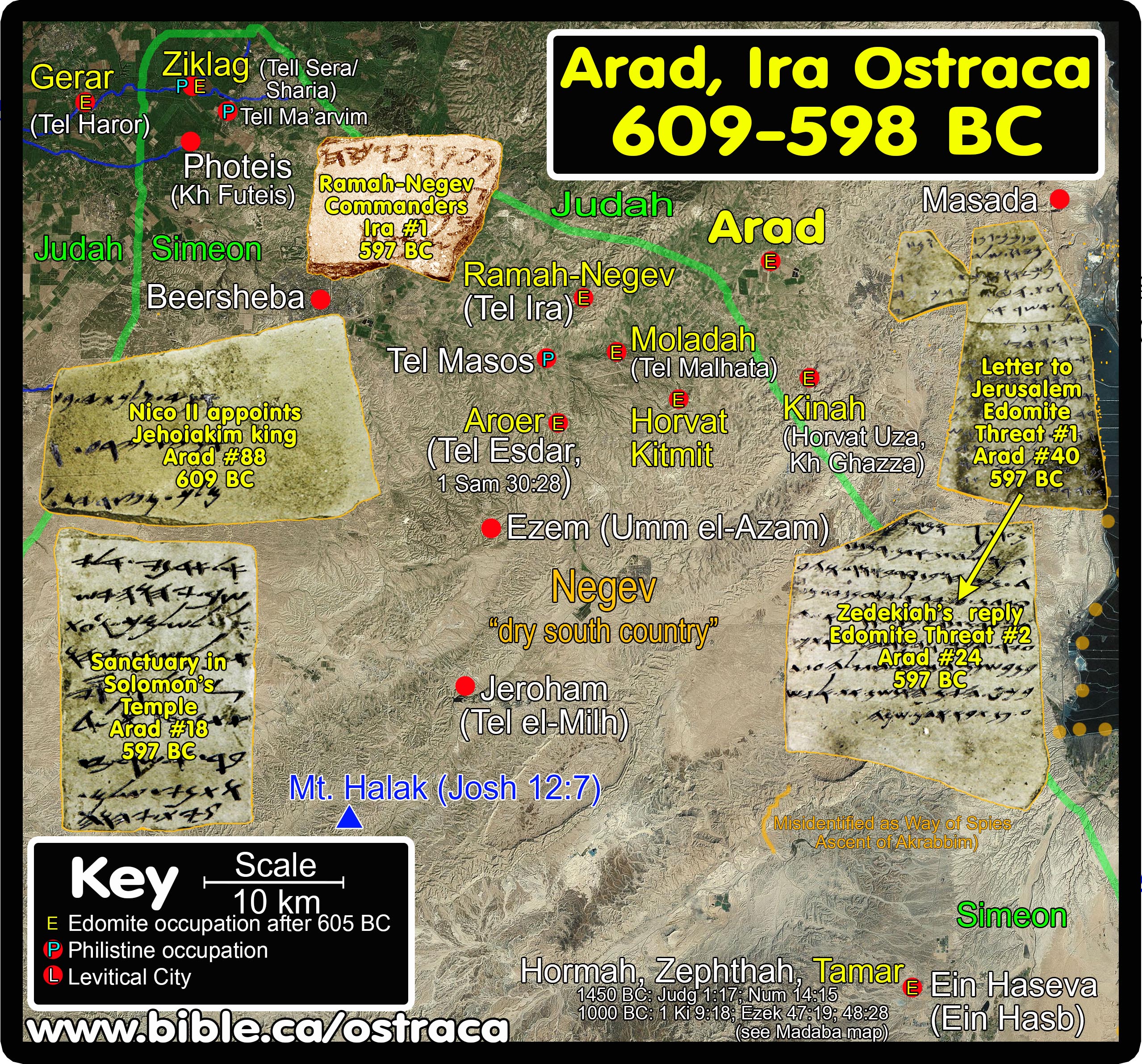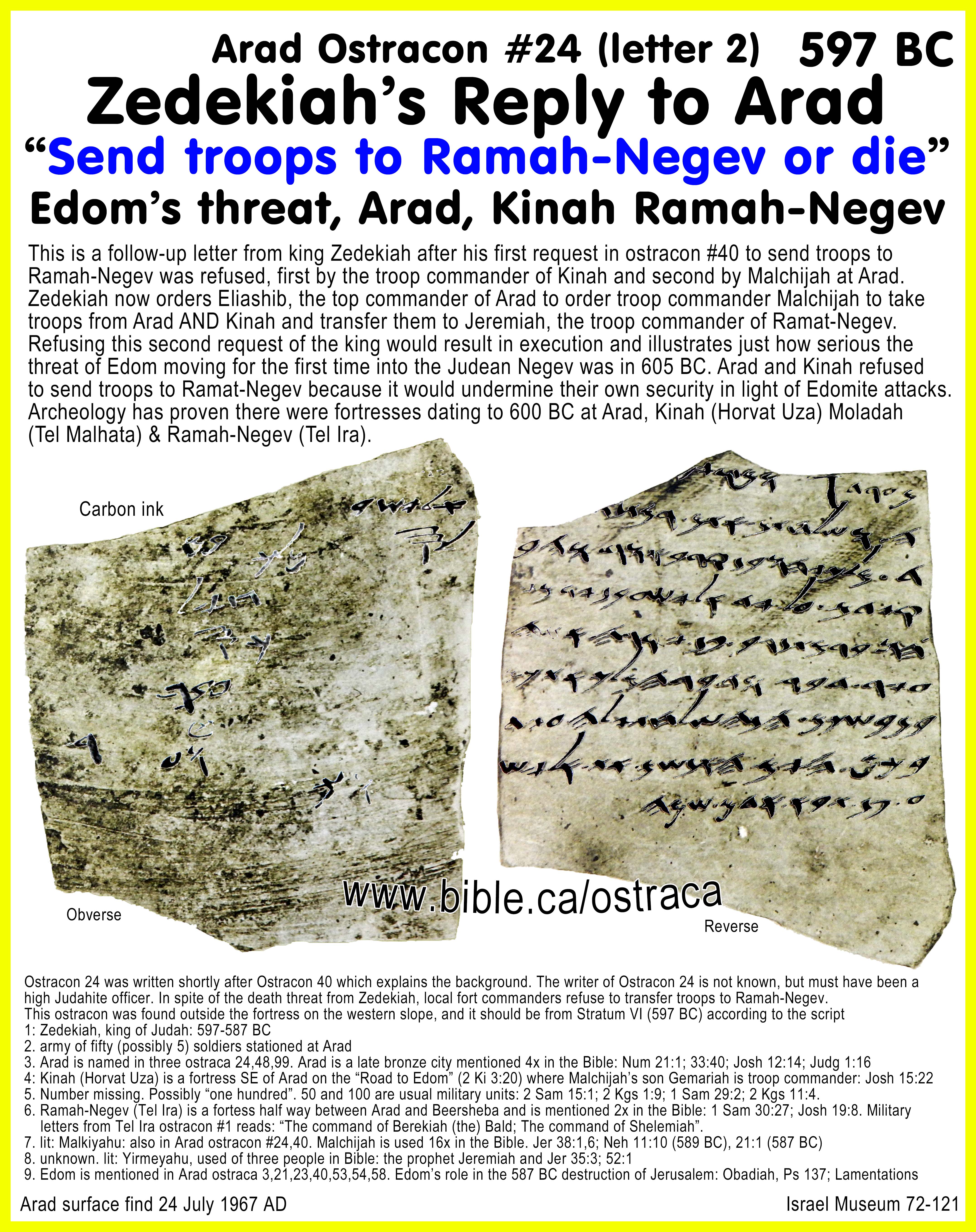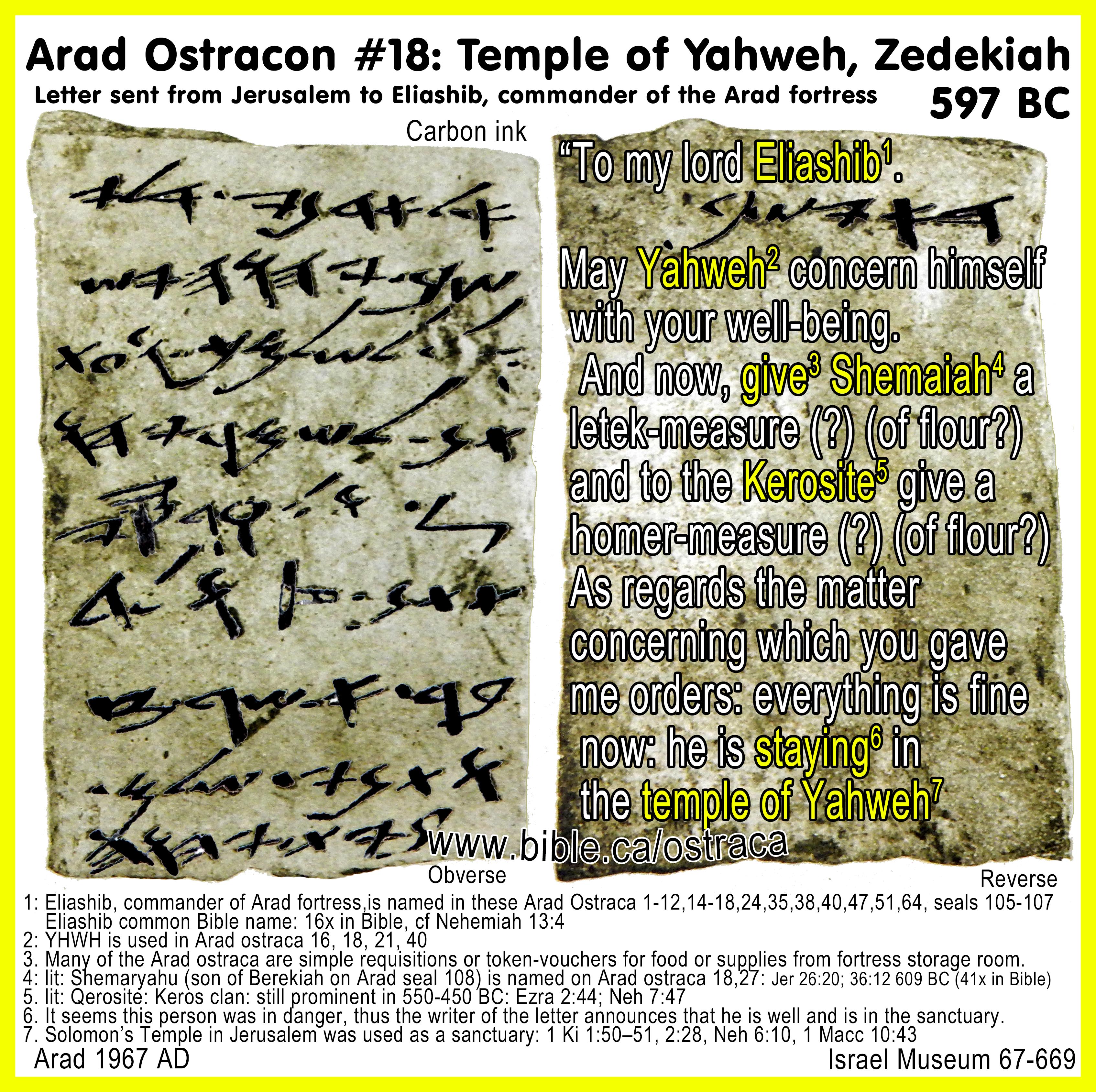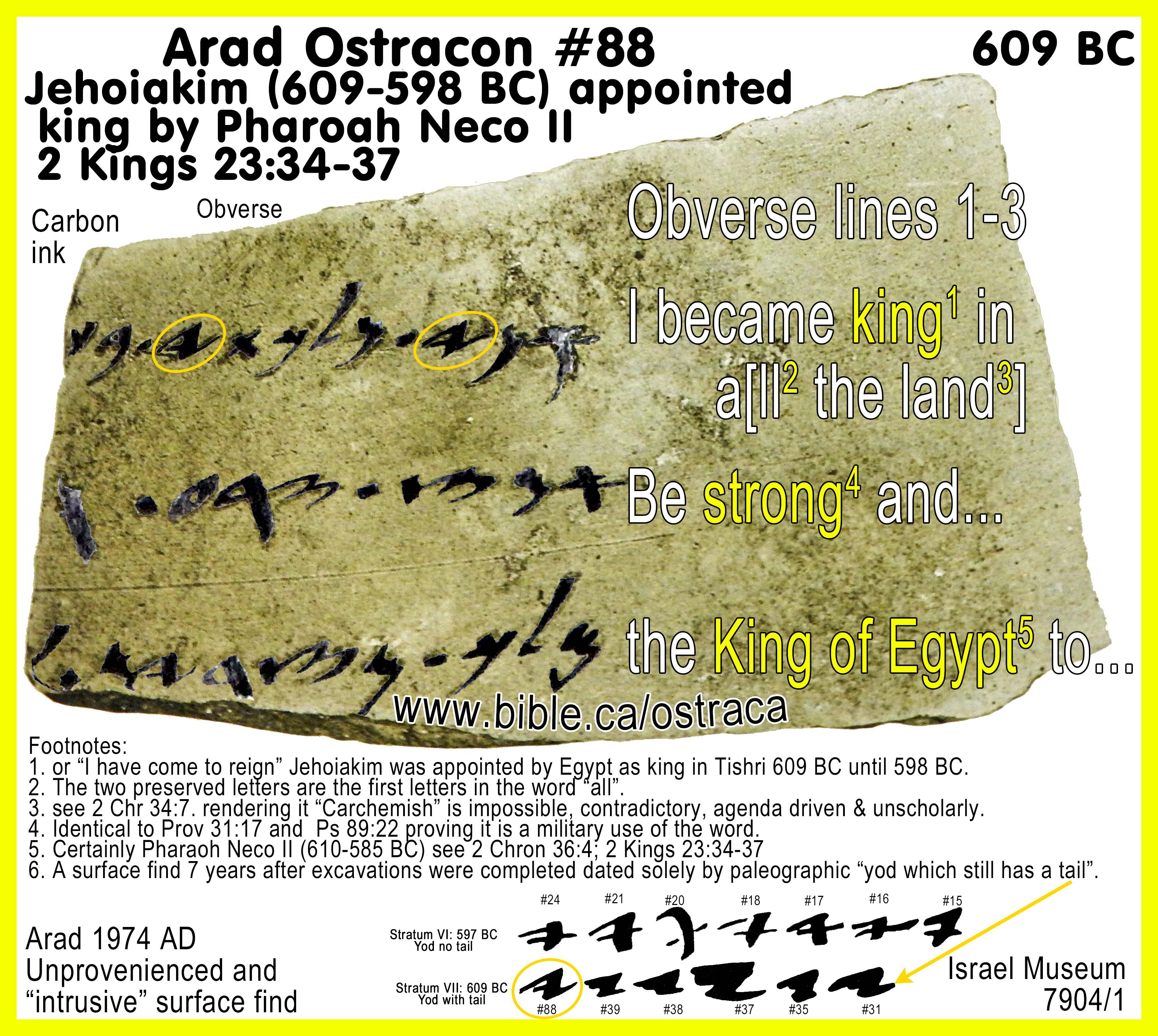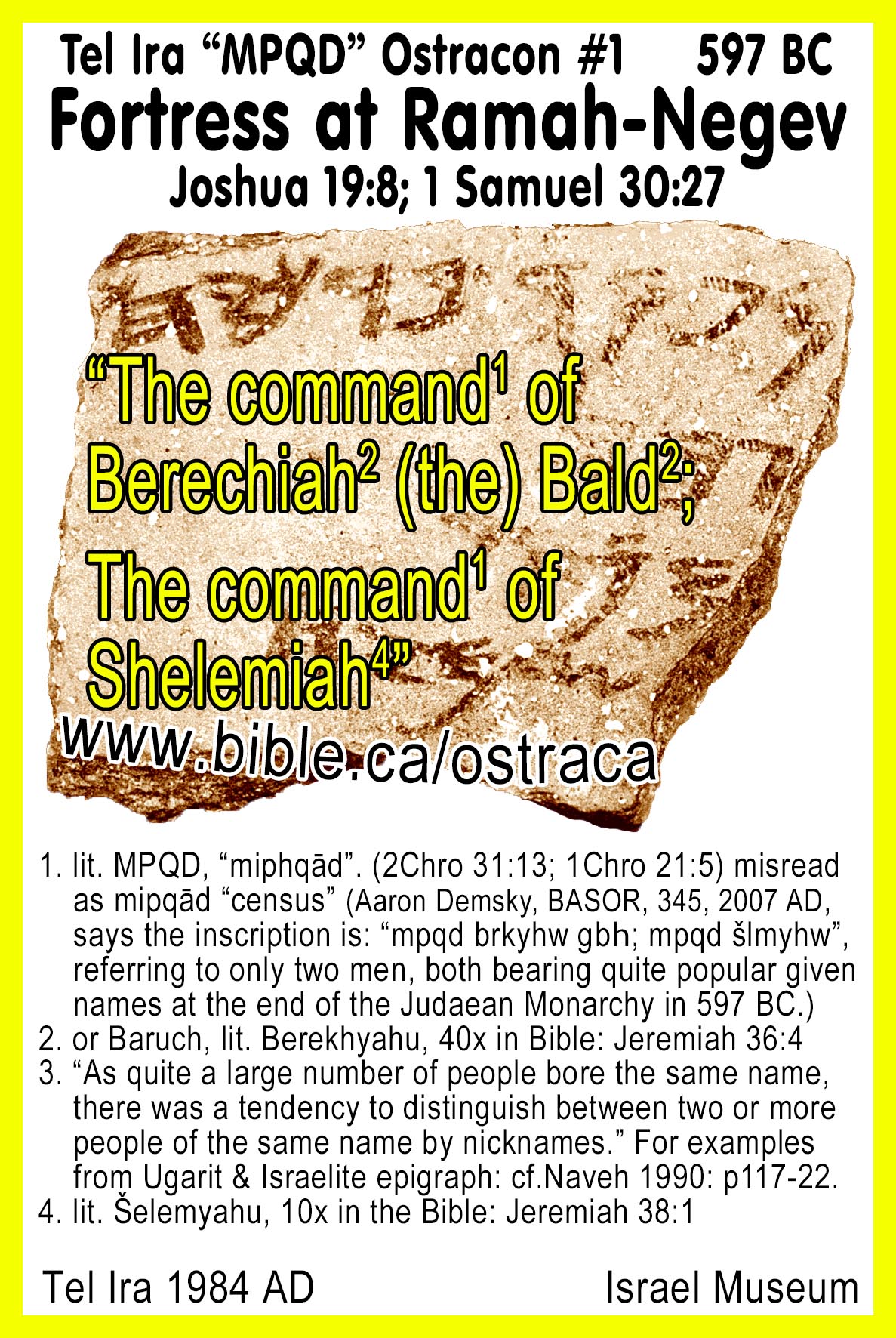Introduction to Arad and Tel Ira Ostraca: 608, 597 BC
Jehoiakim | Zedekiah | Nico II | Solomon's Temple | Edomite invasion into Judah
Ostraca, Tablets and Inscriptions of the Bible
|
Digging up Bible stories! 5 ostraca document 3 important Bible events: 1. Pharaoh Nico II appoints Jehoiakim king of Judah in 609 BC. 2. Edomites move into the Judean Negev and Zedekiah orders troops for defense. 3. A man seeks asylum in the temple of Solomon. See also: Outline on Josiah King of Judah (640-609 BC) Outline on Jehoiakim king of Judah (609-598 BC) Outline on Zedekiah King of Judah (597-587 BC) Outline on Gedaliah 1st Governor of Judah (587 BC) "What we read in the book, we find in the ground" |
|
Arad and Ramah-Negev Ostraca collection 609, 597 BC |
||
|
Arad Letters |
Excavated 1962-1967 AD from an official archeological dig, these ostraca were the written records of communications between Jerusalem and the city of Arad and the king in Jerusalem at the time Nebuchadnezzar attacked Jerusalem 605-587 BC. |
|
|
|
||
|
Edomite attack on Judah |
Edomite attack on Judah |
|
|
|
||
|
Asylum inside the Temple of YHWH |
Jehoiakim becomes king in 609 BC |
|
|
|
||
|
Edomite attack on Judah |
Click to enlarge map |
|
|
|
||
Introduction:
- Ostraca (singular = ostracon) are any type of writing on clay fired pottery
- Ostraca were often created when seals of personal property likely imprinted on large storage jars before they were fired. These ostraca were scribed before the pots were broken. It may be a seal or letters etched into the wet pottery with a stylus before it is dried and fired in the kiln. These are easy to identify because they are three dimensional as opposed to simple ink letters
- The vast majority of ostraca found are ink writing on broken pottery sherds. In these cases the broken pottery was a cheap and abundant paper to write on.
- "In the late monarchic period, the time of these letters, Arad was a fortified supply depot. Staple foods were stockpiled and sent on demand to Judean army units stationed throughout the region. It also served as a troop transit point (see no. 53). Archaeological evidence indicates that the fortress fell temporarily into Egyptian hands in 609. The Egyptians confiscated the supplies in the warehouse and then burned the citadel. Two inventories of foodstuffs, one in hieratic Egyptian, the other in Hebrew, probably date from this incident (Aharoni 1981: 61–64). Shortly thereafter, probably in 604, when Babylonia was on the move and the Egyptians no longer could maintain their influence, the fort was rebuilt by Judah on the same general plan as before. The new citadel stood only about a decade. In 597, while Nebuchadnezzar’s army was invading Judah from the north, the fortress was captured and destroyed again, apparently by raiders from Edom. The excavators of Arad found over a hundred Hebrew inscriptions and ostraca, most of them fragmentary, dating from the ninth century to the early sixth century b.c.e." (Ancient Aramaic and Hebrew Letters, J. M. Lindenberger, Vol. 14, p114, 2003 AD)
- FIVE OSTRACA: From a Biblical point of view, the most important of the 180 ostraca (and a few bulla) excavated at Arad 1962-1967 Ad are the four we have chosen to in this study. We have added one from Tel Ira (Ramah-Negev) for a total of five in this study.
a. Pharaoh Nico II appoints Jehoiakim king of Judah in 609 BC. (Arad #88)
- Two ostraca (Arad #40, #24) record the communications between the city of Arad and Zedekiah, king of Judah at the time Nebuchadnezzar attacked Jerusalem 605-587 BC. The Edomites had moved for the first time into the Judean Negev and Zedekiah orders troops for defense.
c. A man seeks asylum in the temple of Solomon. (Arad #18)
d. A short list of army commanders from Ramah-Negev (Tel Ira #1)
I. Overview of archeological excavation and analysis:
- Excavation report: Aharoni, Y., with the cooperation of Naveh, J. 1975. Arad Inscriptions. Jerusalem (in Hebrew).
- "Eighty-eight Hebrew, eighty-five Aramaic, five Arabic, and two Greek ostraca were discovered during excavations at Tell Arad, in the eastern Negeb, from 1962–1967 (with the exception of Hebrew ostracon 88, found in 1974). Three more Hebrew ostraca were found in 1976. As indicated by paleography and archaeological context, the Hebrew ostraca come from the 10th–6th centuries, the Aramaic from the 5th–4th centuries, the Greek from the 1st–2d centuries c.e., and the Arabic from the 7th–9th centuries c.e." (ABD, Arad Ostraca)
- "The last season of excavations at Arad was in the summer of 1967, and seven years passed before all of the material was ready for publication. Although we have published earlier some of the whole and most important of the ostraca, clearly only a comprehensive edition can give the complete picture. The reason for the delay was the large number of ostraca in which the traces of the script are so faded that their reading is fragmentary. Among the 88 Hebrew ostraca, only 15 are whole, and seven of these include only one name. The contents of another 2 ostraca have been preserved at least in part; in 28, only single words have been preserved; and in the remaining 20, only single letters. Even less has remained of the Aramaic ostraca. Among the 85 ostraca presented in this volume, it is possible to read parts of only 45. In many inscriptions, one can see clearly the traces of the lines of script, but the individual letters are so fuzzy as to be unintelligible." (Arad inscriptions, Joseph Yohanan Naveh, p3, 1981 AD)
- The "Dipping" Archeological Method:
- Dipping is where you take freshly excavated pottery sherds and simply dip them in water to look for possible inscriptions before they are cleaned with a brush.
- "I was excavating a room on the south side of the Israelite fortress at Arad—it was the 1964 season—when Miriam Aharoni, wife of the director of the dig, came rushing over to warn us to be especially careful. We were uncovering an archive of old Hebrew letters, she shouted excitedly. Mrs. Aharoni knew this—and we didn’t—because she had been “dipping” the potsherds from the previous day’s excavation of this area. The “dipping method,” now common on excavations in Israel, was originated by her husband Yohanan Aharoni at Arad. Each sherd is doused in water and examined to see whether it contains an inscription that cannot otherwise be observed because of the dust and dirt clinging to it. If no inscription appears, a light brush is then applied to see whether such an inscription is under dirt still stuck to the sherd. Dipping requires an extraordinary effort, because any Near Eastern dig will uncover thousands of sherds, but the results are often worth the effort. That was certainly true at Arad. Thanks to dipping, a rich collection of epigraphic materials was unearthed at Arad, including political, administrative and cultic documents. We have already described one of two bowls incised with two Hebrew letters, q and k, probably standing for qōdeš kôhanîm, “set apart [holy] for the priests”; the bowls were used in the Israelite temple at Arad. Over 80 other Hebrew inscriptions were found at Arad because of the special care taken to insure that none was overlooked. Moreover, unlike the rare collections of inscriptions found at other sites in Israel, the Arad inscriptions range over a period of 350 years, covering six different strata. As a result, we can study the development of cursive Hebrew script—so-called old Hebrew (as opposed to the later square Hebrew script)—from the United Monarchy, say about 950 B.C., to the Babylonian conquest of Judah in the early sixth century B.C" (The Saga of Eliashib, Office files found of commander of fort at Arad, Anson F. Rainey, BAR 13:02, 1987 AD)
- "The argument of Cross and Freedman (1952: 57; Freedman 1962) that the Judahite dialect did not reduce diphthongs generally before the exile is not contested by the Arad ostraca. There, clear internal matres seem to have been adopted from earlier final maws, though sporadic contraction of aw in a few words had possibly already taken place (Rainey 1972). Waw for medial a was in sporadic use by the time of the Royal Steward Inscription, ca. 700 B.C. By the time of the Arad corpus, its use seems universal, except for the archaic frozen form of the pronoun h'. Yod for medial i appears to have been introduced at the same time or slightly later. The Siloam Tunnel Inscription, which still writes stir defectively, also attests defective Unfortunately, the Steward Inscription does not provide a word which would show a Hip` il or stem i. Yod for i is not universal at Arad, but it is regular. That is, i of the plural or of the 1st s. nom. suf. internalized by another ending is never marked, while i from a root or from the Hip` i1 always is. Other than ii and i, medial long vowels at Arad are consistently unmarked. [Footnote: A. F. Rainey's study. "'Three Additional Hebrew Ostrava from Tel Arad.", Aviv 4 (1977): 97-104, came to hand after this article was sent to press. It should be consulted for several relevant readings.]" (The Orthography of the Arad Ostraca, H. Van Dyke Parunak BASOR 230: 25-31, 1978 AD)
II. Ostraca from different occupation periods:
- Arad is a city with a long period of occupation and as such we should not be surprised to find many different periods of ostraca.
- The archeological dig report says that ostraca was found in these occupation levels, each of which correspond to a date: Stratum II, III, V, VI, VII, VIII, X, XI.
- "Stratum VI (605-595 BC, Jehoiakim, Zedekiah] was the last stratum before the fort was destroyed in the early sixth century, just before the Babylonians destroyed Jerusalem. Without knowing it, we had been digging in the office of the Israelite commander of the Arad fort. His name was Eliashib son of Eshiyahu. Three of his seals were found on the floor of a room on the south side of the fort in stratum VII (c. 620–597 B.C.). They are beautifully preserved seals that simply read “[Belonging] to Eliashib son of Eshiyahu” in two lines. Remnants of a string were even found threaded in two of the seals. It is interesting that they are “private” seals, although we now know from the archive that Eliashib was not a private citizen, but was in fact a responsible officer of the fort. This suggests that other so-called private, as opposed to royal, seals probably belonged to important government officials even though they did not bear titles. Eliashib may have been commander of the fort. He not only served there during stratum VII, as we know from the seals, but also in stratum VI, as we know from the archive found in his office. … In my view, stratum VII at Arad was destroyed not by Pharaoh Necho, but by the “bands of raiders” sent by Nebuchadnezzar, the Babylonian ruler who later destroyed Jerusalem in 587 B.C. These raiders probably destroyed stratum VII at Arad in a softening up operation against Judah in 598/597 B.C." (The Saga of Eliashib, Office files found of commander of fort at Arad, Anson F. Rainey, BAR 13:02, 1987 AD)
- "Stratum VII (seventh century B.C.E.) The plan of the citadel and its buildings was again similar to its predecessors. The outstanding innovation here is the addition of an interior wall parallel to the whole southern wall of the fortress. Thus the living quarters located here were truncated and their southern portions became small casemate rooms. In one of these rooms. near the eastern corner (Locus 779), the seals of Eliashib were found. Stratum VI (end of the seventh, beginning of the sixth century B.C.E.) This is the last Israelite citadel: it existed for only about ten years. The fortress was encircled by a new casemate wall which had towers projecting at the corners and in the middle of each side, similar to the fortresses of Kadesh-Barnea [Ein Qudeirat] and Hot-vat Uzza.'2 Along the western side and in the northwest corner. a completely new wall was built, whereas the rest of the wall was rebuilt along the lines of the old wall. In the south, the interior line of the casement wall of Stratum VII became the exterior wall of Stratum VI. The general plan of the fortress was not changed in this stratum except for two things: the sanctuary ceased to exist. most of it being buried under the wall: and the gate was moved to the north side. It would seem that the two changes were connected: with the cancellation of the sanctuary, the area became a courtyard into which a new gate led. (Arad inscriptions, Joseph Yohanan Naveh, p8, 1981 AD)
- Note: + numbers in totals are ostracon dated based upon epigraphical comparison as opposed to where they were found. It is common in archeology to find pottery and objects of one date in a stratum level from another time period.
|
Archeological level |
Interpreted date |
Total number of ostraca found |
|
Stratum I |
Bedouin caves modern |
0 |
|
Stratum II |
7-9th century AD (Islamic) |
5 |
|
Stratum III |
1-2nd century AD (Roman) |
2 |
|
Stratum IV |
3rd - 1st century BC |
0 |
|
Stratum V |
5th - 4th century BC (Persian) |
85 |
|
Stratum VI |
605 - 595 BC (Jehoiakim, Zedekiah) |
22 + 10 |
|
Stratum VII |
7th century BC |
3 + 10 |
|
Stratum VIII |
End of 8th century BC |
18 + 4 |
|
Stratum IX |
8th century BC |
10 |
|
Stratum X |
9th century BC |
4 + 7 |
|
Stratum XI |
10th century BC |
4 + 2 |
|
Stratum XII |
12th -11th century BC |
0 |
III. The ostraca are of five general categories:
- Personal letters (Arad Ostraca #40, #24, #88, #21, #26, #111)
- Lists of names of people in various groups for various reasons "#49: sons of Besel 3, sons of Korah 2, sons of Gilgal 1 etc" (Arad Ostracon #22, #23, #27, #49, #35, #38, #39, #58, #59, #72)
- Vouchers used to redeem goods, supplies, food, money.
- A voucher for one person to redeem goods. Often there is no name so the ostracon was valid to whomever turned it in like generic food stamps: (Arad Ostraca #3, #6, #9, #12, #13, #18, #25, #33, #34, #41, #60, #61, #65, #79, #81, #112)
- A voucher that authorizes goods to be given to a list of names or a group (Kittiyim): (Arad Ostraca #1, #2, #4, #5, #8, #10, #11, #14, #22, #31, #76, #110)
- "Kittiyim, referred to in the voucher discussed above, are mentioned frequently in the ostraca. These are the Kittim of the Bible. The name comes from Kition, a city on the Mediterranean island of Cyprus where the population was mainly of Phoenician origin. The Kittim thus spoke a language closely akin to Hebrew, and could easily converse with Eliashib. These Kittim or Kittiyim might have been mercenaries in the service of Judah. " (Ancient Aramaic and Hebrew Letters, J. M. Lindenberger, Vol. 14, p114, 2003 AD)
- A voucher authorizing supplies to be sent to other nearby cities: (Ziph: Arad Ostraca #17)
- Markings of personal property likely imprinted on large storage jars before they were fired. These ostraca were scribed before the pots were broken. While they are ostraca, the vast majority of ostraca found are writing on broken pottery sherds. In these cases the broken pottery was a cheap and abundant paper to write on. (Arad Ostracon #55, #56, #57, #74)
- "Belonging to Hanan" (Arad Ostracon #92)
- "Belonging to Zadok" (Arad Ostracon #93)
- "Son of Ezer" (Arad Ostracon #51)
- "Malachi" (Arad Ostracon #97)
- Ink writing on fired storage pottery vessels to indicate either what is inside, or how much had been incrementally taken out, in a kind of inventory control record: (Arad Ostraca #46)
IV. The "voucher system" for supplies in 597 BC
- Vouchers were written on pottery sherds that acted like tokens or "I owe you" that could be exchanged for various goods stored at the Arad fortress from the time of Josiah (640 BC) down through Zedekiah (597 BC) and then to the Persian era 500 BC.
- "Kittiyim, referred to in the voucher discussed above, are mentioned frequently in the ostraca. These are the Kittim of the Bible. The name comes from Kition, a city on the Mediterranean island of Cyprus where the population was mainly of Phoenician origin. The Kittim thus spoke a language closely akin to Hebrew, and could easily converse with Eliashib. These Kittim or Kittiyim might have been mercenaries in the service of Judah. In one ostracon the Kittim are given provision for “the four days”: “To Eliashib: And now give the Kittiyim two baths of wine for the four days, and 300 [loaves of] bread.” The voucher obviously came from a person of higher rank than Eliashib for it also admonishes him somewhat testily, “Don’t delay.” The use of the definite article “the” in “the four days” suggests that there must have been a definite organized route and way stations through the desert based on units of distance per day. This was not provision for “a” four-day journey, but for “the” four-day journey, probably with specific stopovers and a final destination, in this case, probably Kadesh’Barnea, where the unit of Kittiyim would be reprovisioned. We can also draw some conclusions as to the size of the military unit from the amount of the provision. When Zedekiah imprisoned the prophet Jeremiah, Jeremiah was allotted a ration of one loaf of bread a day (Jeremiah 37:21), no doubt a minimal portion, which is why it is specifically mentioned. Military units traveling in the desert were also minimally supplied—say two loaves a day for each man. If this is accurate 300 loaves of bread for four days indicates a unit of about 35–40 men (who would be given two loaves of bread each for four days)." (Ancient Aramaic and Hebrew Letters, J. M. Lindenberger, Vol. 14, p114, 2003 AD)
- The units of measure of supplies included:
- Bath
- Homer
- Hekat (a symbol for standard measurement amount, followed by a number ie "Hekat 4" = 4 standard measures)
- Ephah
- Donkey load
- Jar
- The sorts of supplies seen in the ostraca is fascinating:
- Food: flower, grain, wheat, barley, bread, oil, wine, vinegar,
- Money: silver, shekels,
- Horses, donkeys, camels (ostraca from Persian occupation period)
- "A number of ostraca in the archive appear to be vouchers presented to Eliashib as commander of the fortress for the issuance of supplies from the fortress storehouses. Unfortunately, the vouchers do not contain the names of the senders. But it is clear from other letters that various groups passed through Arad and were provisioned there. For this purpose, at the beginning of their journey they were given vouchers addressed to Eliashib with specific instructions as to the amount and type of provisions they were to be issued. The vouchers thus authorized the release of provisions from the fortress storehouses. The administrators of Arad then kept the vouchers as receipts. Apparently, Eliashib was instructed, according to standard practice, to write on the back the date he satisfied the voucher; one of the vouchers states: “To Eliashib: And now [the standard opening], give the Kittiyim three baths of wine, and write the name of the day.” The voucher goes on to list the amount of flour to be issued. On the back of one of the vouchers, the date is written in a handwriting different from that on the front." (Ancient Aramaic and Hebrew Letters, J. M. Lindenberger, Vol. 14, p114, 2003 AD)
V. 5 Seals found at Arad:
- Seal stones and rings used to make clay bulla as marks of authority or property
- Stones of various type.
- Inscribed in reverse text so when they are imprinted in clay, the writing is normal text
- Often impeded in rings or worn around the neck or wrist.
- Usually in two or three lines of text. (Lines are separated by "|"). All are two lines except #108 which is three lines.
- Three different seals (#105-107) of Eliashib, commander or supply manager of the Arad fortress were all found in the same room of stratum VII (597 BC) along with Arad ostraca #31,32,34 and other pottery.
- Text of the five Arad seals:
- [Belonging] to Eliashib | son of Ehiyahu (Arad seal #105)
- [Belonging] to Eliashib | son of Ehiyahu (Arad seal #106)
- [Belonging] to Eliashib | son of Ehiyahu (Arad seal #107)
- [Belonging] to Berekyahu | son of […]hu | son of Shelemyahu (Arad seal #108)
- [Belonging] to Darshiya- | hu son of Ez[er] (or Uzza) (Arad seal #109)
VI. Who was Eliashib and what was his role at Arad?
- There are two proposals as to Eliashib's function at the Arad fortress:
- Eliashib was the top ranking official and/or commander of the entire Arad fortress. This is the view taken by the dig directors at Arad.
- “To Eliashib: And now give the Kittiyim two baths of wine for the four days, and 300 [loaves of] bread.” The voucher obviously came from a person of higher rank than Eliashib for it also admonishes him somewhat testily, “Don’t delay.” The use of the definite article “the” in “the four days” suggests that there must have been a definite organized route and way stations through the desert based on units of distance per day." (Ancient Aramaic and Hebrew Letters, J. M. Lindenberger, Vol. 14, p114, 2003 AD)
- Eliashib was a non-military bureaucrat of the king: We, on the other hand, believe Eliashib was not the commander but functioned under the commander as executive director of supplies and logistics. He may have been an official appointed by king Zedekiah to control the flow of goods and even troops as the kings command. The commander of the entire Arad fortress was a soldier who directed troops the king assigned through the direction of the king via Eliashib in battle. So instead of the military commander of the fortress, Eliashib was a non-military bureaucrat of the king.
- Archeological objects connected with Eliashib:
- Many ostraca were found with Eliashib's name on it
- Three seals used to secure documents with string by pressing the seal into clay, thus creating a bulla, were found in a single room with the inscription "[Belonging] to Eliashib | son of Ehiyahu". (see below)
- "The most chilling episode in Eliashib’s career came to light three years after the discovery of the archive in his office. I was supervising the excavation of the slope outside the fortress on the western side. An American volunteer from the University of North Carolina came running over with an inscribed sherd she had just found. It was a letter to Eliashib, but unfortunately only the back side was well preserved. From the script, we could tell that it had come from the stratum VI fortress. It was an order to rush troops from Arad and from neighboring Kinah to strengthen the defenses of Ramah-Negeb (probably Tel ‘Ira, southwest of Arad on a hill overlooking the entire Beer-Sheba Valley): “To Eliashib … king … troop … from Arad 50 and from Kin[ah] … and you shall send them to Ramah-Negeb. … ” The message is stringent—not to say hard-boiled: “The word of the king is incumbent on you for your very life! Behold I have sent to warn you today.” Ramah-Negeb had to be defended, “lest Edom should come there.” When the Edomites to the south and east saw that Judah was under heavy pressure from the Babylonians, the Edomites invaded the Negeb, occupied southern Judah and even cheered when Nebuchadnezzar destroyed Jerusalem (Obadiah 1:10, 14; Psalm 137:7). It was in this context that Eliashib was ordered to rush troops from Arad and Kinah for the defense of Ramah-Negeb. This defense probably failed." (Ancient Aramaic and Hebrew Letters, J. M. Lindenberger, Vol. 14, p114, 2003 AD)
Conclusion:
- From Arad ostraca #88 we have direct evidence that Pharaoh Nico II appointed Jehoiakim, king of Judah in 605 BC just like the Bible says.
- Details of Arad #88 "Neco II appoints Jehoiakim" in 609 BC
- "Pharaoh Neco made Eliakim the son of Josiah king in the place of Josiah his father, and changed his name to Jehoiakim. But he took Jehoahaz away and brought him to Egypt, and he died there. So Jehoiakim gave the silver and gold to Pharaoh, but he taxed the land in order to give the money at the command of Pharaoh. He exacted the silver and gold from the people of the land, each according to his valuation, to give it to Pharaoh Neco. Jehoiakim was twenty-five years old when he became king, and he reigned eleven years in Jerusalem; and his mother’s name was Zebidah the daughter of Pedaiah of Rumah. He did evil in the sight of the Lord, according to all that his fathers had done." (2 Kings 23:34-37)
- From the Arad ostraca #40 and #24 we clearly see the invasion of Edom for the first time into Judean territory which generated two letters between king Zedekiah and the commanders at the Arad fortress to send troops for defence to neighboring fortresses under attack.
- First letter: Details of Arad #40 "Letter to Zedekiah"
- Second letter: Details of Arad #24 "Zedekiah's Reply"
- This deeply troubled Zedekiah and he lost the battle in the end with the destruction of the temple in 587 BC.
- After this Edom moved into occupy the Negev in Arad and other near by cities.
- See outline on Edom
- map of Edomites moving into Judah after 605 BC:
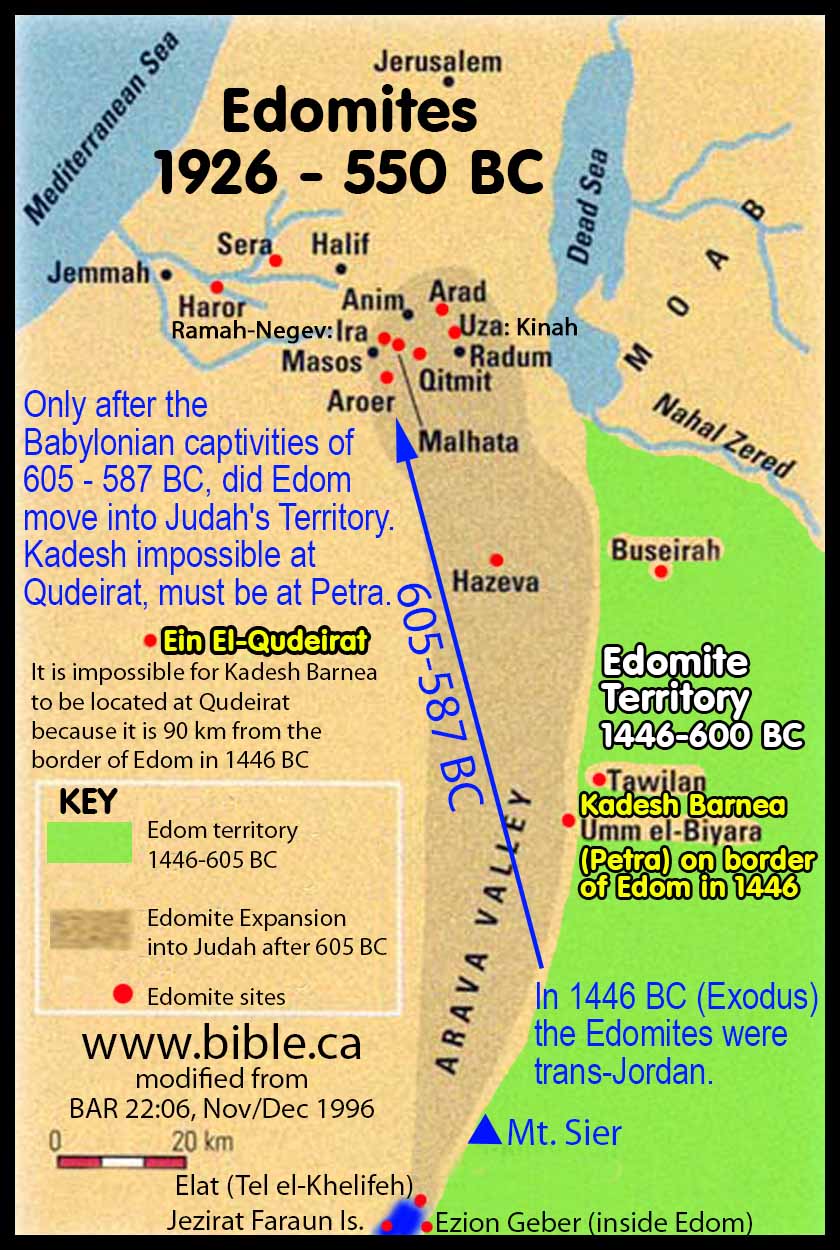
- From Arad ostraca #18 we have a direct reference to the Temple of Solomon in 597 BC where a man was seeking refuge inside for reasons unknown.
- Details of Arad #18 "Solomon Temple Sanctuary"
- This may be the very last reference to the first temple period sanctuary we have form archeology.
- The Arad ostraca and seals provide a vivid picture of the world of Zedekiah, king of Judah in 597 BC.
- The ostraca show the internal workings of government from Jerusalem to the outer fortresses in the negev of Judah.
- We see the kinds of commodities being traded and the types of food consumed.
- The one ostracon from fortress at Ramah-negev (Tel Ira) is ten km west of Arad and shows two commanders received orders there in 597 BC.
- See also:
a. Outline on Josiah King of Judah (640-609 BC)
b. Outline on Jehoiakim king of Judah (609-598 BC)
c. Outline on Zedekiah King of Judah (597-587 BC)
- Outline on Gedaliah 1st Governor of Judah (587 BC)
- What you read in the book you find in the ground!
By Steve Rudd: Contact the author for comments, input or corrections.
